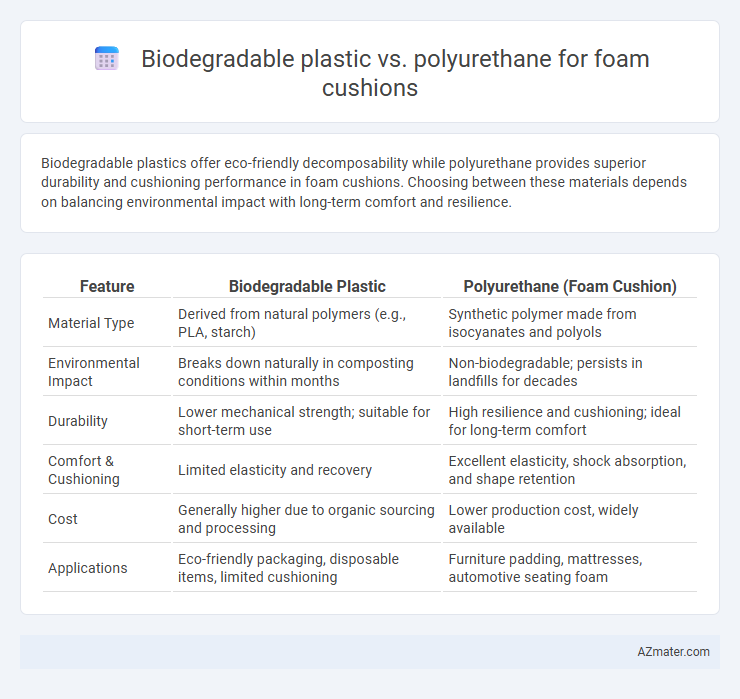Biodegradable plastics offer eco-friendly decomposability while polyurethane provides superior durability and cushioning performance in foam cushions. Choosing between these materials depends on balancing environmental impact with long-term comfort and resilience.
Table of Comparison
| Feature | Biodegradable Plastic | Polyurethane (Foam Cushion) |
|---|---|---|
| Material Type | Derived from natural polymers (e.g., PLA, starch) | Synthetic polymer made from isocyanates and polyols |
| Environmental Impact | Breaks down naturally in composting conditions within months | Non-biodegradable; persists in landfills for decades |
| Durability | Lower mechanical strength; suitable for short-term use | High resilience and cushioning; ideal for long-term comfort |
| Comfort & Cushioning | Limited elasticity and recovery | Excellent elasticity, shock absorption, and shape retention |
| Cost | Generally higher due to organic sourcing and processing | Lower production cost, widely available |
| Applications | Eco-friendly packaging, disposable items, limited cushioning | Furniture padding, mattresses, automotive seating foam |
Introduction to Foam Cushion Materials
Foam cushions are commonly made from materials such as polyurethane and increasingly, biodegradable plastics, which offer differing environmental impacts and performance characteristics. Polyurethane foam is prized for its durability, flexibility, and cushioning properties, making it a standard choice in furniture and automotive applications. Biodegradable plastic foams provide an eco-friendly alternative by breaking down naturally, reducing landfill waste but often have varying resilience and cushion support compared to traditional polyurethane foams.
Overview of Biodegradable Plastics in Cushioning
Biodegradable plastics in cushion foam offer an eco-friendly alternative to traditional polyurethane by breaking down naturally through microbial action, reducing environmental impact and landfill accumulation. These materials, often derived from renewable resources like cornstarch or polylactic acid (PLA), provide comparable cushioning performance while enhancing sustainability. Their adoption supports circular economy goals by minimizing plastic waste and promoting compostability in various cushioning applications.
What is Polyurethane Foam?
Polyurethane foam is a versatile polymer widely used in foam cushions for its durability, flexibility, and excellent cushioning properties. Unlike biodegradable plastics, polyurethane foam is derived from petroleum-based chemicals, which provide long-lasting support and resistance to wear and tear. This material's unique cellular structure allows it to absorb impact efficiently, making it a preferred choice in furniture, automotive, and packaging industries.
Environmental Impact: Biodegradable Plastic vs Polyurethane
Biodegradable plastics significantly reduce environmental impact by breaking down naturally through microbial activity, minimizing landfill accumulation and reducing toxic chemical release compared to polyurethane foams. Polyurethane cushions persist in the environment for decades, contributing to long-term pollution and microplastic contamination in ecosystems. The adoption of biodegradable plastic alternatives supports improved waste management and lower carbon footprints in foam cushion production.
Performance and Durability Comparison
Biodegradable plastics used in foam cushions typically offer moderate durability and reduced environmental impact, breaking down under composting conditions within months to a few years. Polyurethane foam cushions provide superior performance with high resilience, excellent cushioning support, and long-lasting durability often exceeding a decade under regular use. While polyurethane outperforms biodegradable plastic in longevity and mechanical strength, the latter serves as a sustainable alternative suited for temporary cushioning applications where reduced ecological footprint is prioritized.
Cost Analysis of Biodegradable and Polyurethane Foams
Biodegradable foam cushions typically have higher production costs compared to polyurethane foams due to expensive raw materials and complex manufacturing techniques. Polyurethane foams offer cost efficiency with lower raw material prices and established mass production processes, making them more economical for large-scale cushioning applications. Evaluating total lifecycle expenses, including disposal and environmental impact fees, may favor biodegradable foams despite their higher upfront costs.
Comfort and User Experience Factors
Biodegradable plastic foam cushions offer enhanced breathability and eco-friendly cushioning, resulting in improved comfort through better temperature regulation and reduced environmental impact. Polyurethane foam cushions provide superior durability and support with higher resilience and consistent density, which enhances long-term comfort and user experience. User preference often depends on balancing the biodegradable option's environmental benefits against polyurethane's proven comfort and longevity.
Manufacturing Processes and Scalability
Biodegradable plastics for foam cushions typically involve processes such as extrusion or injection molding using renewable polymers like polylactic acid (PLA) or starch-based blends, which require careful control of moisture and temperature to maintain material integrity. Polyurethane foam manufacturing utilizes chemical reactions between polyols and isocyanates, enabling precise tuning of density and resilience through continuous reaction injection molding or slabstock processes. While polyurethane manufacturing benefits from well-established industrial scalability and cost-efficiency, biodegradable plastic foam production faces challenges in scalability due to raw material variability and slower processing speeds.
End-of-Life: Disposal and Recycling Options
Biodegradable plastics used in foam cushions decompose under specific composting conditions, reducing landfill impact but often lack widespread industrial composting facilities for effective disposal. Polyurethane foam, commonly used in cushions, presents significant recycling challenges due to its chemical complexity and limited recycling infrastructure, often resulting in landfill accumulation or energy recovery through incineration. Emerging technologies focus on chemical recycling and mechanical reprocessing for polyurethane, yet these methods remain less accessible compared to the growing composting systems available for certain biodegradable plastics.
Future Trends in Eco-Friendly Cushion Materials
Biodegradable plastics are gaining traction in foam cushion manufacturing due to their reduced environmental impact and ability to decompose naturally, addressing increasing consumer demand for sustainable products. Polyurethane foam, traditionally dominant for its durability and comfort, is evolving with enhanced formulations incorporating bio-based polyols to improve eco-friendliness without compromising performance. Future trends emphasize hybrid materials combining biodegradable polymers and bio-based polyurethanes, aiming to balance sustainability, durability, and comfort in eco-friendly cushion solutions.

Infographic: Biodegradable plastic vs Polyurethane for Foam cushion
 azmater.com
azmater.com